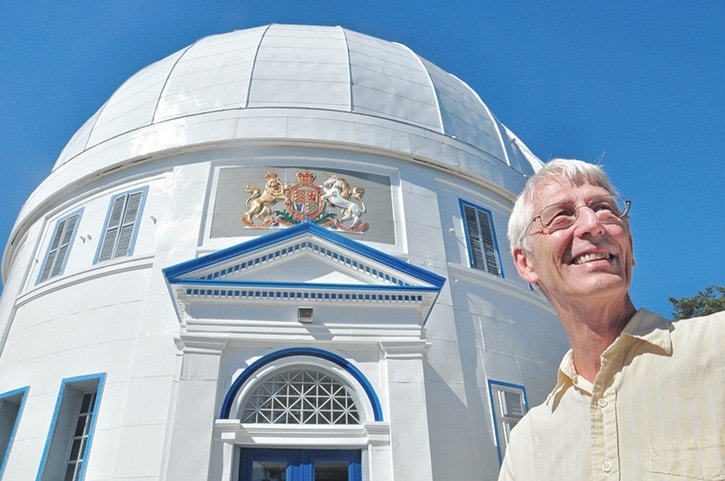The view from Gregory Fahlman’s office is all lush forest and green canopy. Working from the perch of Little Saanich Mountain can feel a touch monastic, but it is the centre of the universe, at least for Canadian astronomy.
Astronomers still use the iconic 1.8-metre Plaskett telescope within the dome visible from across Greater Victoria, and its smaller 1.2 m cousin, but the meat of Canadian astronomy takes place in the far off mountains of Hawaii and Chile.
It’s fitting then that one of the key players in Canadian astronomy found out about his Order of B.C. through “an urgent message at an ungodly hour” while at a meeting in Hawaii for the Thirty Meter Telescope (TMT), a project to build the largest and most powerful ground-based optical telescope ever conceived.
An astronomer since 1971 and the director general of the National Research Council’s national astronomy and astrophysics programs for the past 10 years, Fahlman was named to the Order of B.C. for his efforts to establish Canada as a world leader in astrophysical research.
He laughs as he deflects his role as a “paper shuffler,” but in reality he oversees Canada’s interests in cutting-edge technology that can peer into the deepest depths of the universe, while based out of the NRC complex at the Dominion observatory in Saanich. The facility has slightly more than 100 staff.
“A lot of people don’t realize that this is the headquarters for the national program for Canadian astronomy,” Fahlman said. “What we do here mainly is look after Canadian interests in front-line telescopes.”
The “front line” includes such monster devices as the 3.6m Canada-France-Hawaii telescope and the 15m James Clerk Maxwell telescope, both on Mauna Kea; the Gemini Observatory, with twin 8.1m telescopes in Chile and Mauna Kea; and the Atacama Large Millimeter/submillimeter Array (ALMA), a radio telescope with 66 antennas in Chile. To greater and smaller degrees, Canada funds and maintains these resources.
“What do I do? I shuffle paper and keep the show going,” Fahlman said. “Partly it’s experience and knowing a fair number of people. It’s about providing the glue. I have a broad view of things, but there are so many other people involved. One person doesn’t do everything.
"My position, most of my time and energy goes into managing this and keeping it all 'copasetic' with our international partners. This is where the rubber hits the road with Canadian astronomy."
Fahlman and staff in Victoria help Canadian astronomers figure out the best ways to use the major telescopes, all of which have complicated back-end technology, some of it designed and built by scientists at the observatory. Recently, local engineers built 73 devices that detect microwaves from the deep cosmos for the ALMA telescope.
“(The device) is one of the most sensitive things in the world,” Fahlman says. “The engineering, design and construction of instruments for these telescopes is really complicated stuff, and it’s done here.”
Canadian astronomers have made major discoveries under Fahlman’s watch, including the first images of a solar system outside of our own. He was in charge of the Canada-France-Hawaii telescope when astronomers used an oversized digital camera aptly called MegaCam to figure out the weird properties of an expanding universe. “It’s only something astronomy could discover and it’s still not well understood.”
Beyond the observatory in Saanich and a radio observatory in Penticton, it’s unlikely new large telescopes will ever be built on Canadian terra firma due to poor weather and northern latitude. The future of Canadian astronomy lies with technology development roles in the Thirty Meter Telescope and the Square Kilometre Array, another ambitious radio telescope split between Australia and South Africa.
“It’s a bit of a monasterial feeling up here (on Little Saanich Mountain),” Fahlman said.
“But we have interests in every continent on the globe. We have visitors every day from other countries. It’s like (connections) go out from this place and connect Canadian astronomy to the world.”
editor@saanichnews.com
A universe of data
The Dominion observatory in Saanich also hosts the Canadian Astronomy Data Centre, a massive database of 500 terabytes (on the order of 500,000 feature length movies) of astronomical data from Canadian telescopes and is one of three distribution centres for data from Hubble space telescope.
The database is accessed by astronomers in Canada and from around the world.
